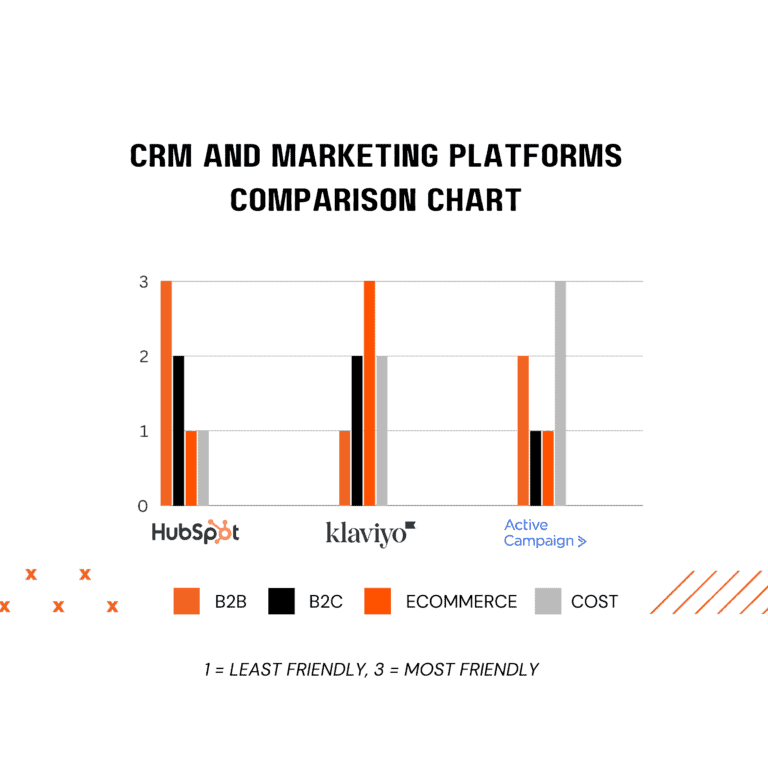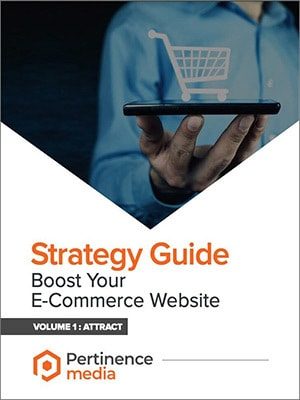This article will address many questions that you may have in regards to the decision of which CRM and email marketing platforms that you would like to implement into your business, for instance:
- What is the purpose of each automation platform?
- Which automation platform best meets my budget?
- What are the key and unique features of each MarTech platform?
- What are the advantages and disadvantages of each CRM platform?
- Which CRM and email platform should I use for my business?
- How to effectively leverage each MarTech platform for my business?
- Etc.
After reading this article, you will have the fundamental knowledge and information in order to make the best decision when deciding which MarTech platform that best suits your company’s needs.
HubSpot
What is HubSpot?
HubSpot is a powerful CRM platform that simplifies many areas of a business by providing sophisticated tools; from marketing, to sales, to customer service. It’s an all-in-one platform that enhances cohesion between departments of an entire company.
Because of its prowess, this platform is expensive, especially if purchased as a whole. However, users have the option to purchase a single or multiple features (referred as a Hub) that best suit their company’s needs. For instance, bundles can range from US$540 annually for the Starter bundle to US$19,200 for the Professional bundle and US$60,000 for the Enterprise bundle, but users can have the ability to customize their bundle. Each individual hub can vary dramatically based on the features that you decide to obtain.
What are HubSpot’s features?
HubSpot has a variety of advanced tools that allows companies to leverage them all in different ways, either alone or altogether. For example, below is an overview of the anatomy of HubSpot’s features:
- Marketing Hub: This feature allows users to create email marketing, landing pages, social media, blogs, etc.
- Sales Hub: This features stores contacts information, meeting scheduling, lead scoring, etc.
- Service Hub: This feature allows for ticketing, team email, live chat, custom support forms, etc.
- CMS Hub: This feature allows for website hosting, website creation, SEO, etc.
- Operations Hub: This feature allows for data sync, datasets, etc.
Each of HubSpot’s categories can be automated for greater use. For instance, when automating sales, it allows users to automatically generate contact information and store them neatly, in addition to automatically developing on the sales pipeline. Another example is marketers can schedule paid media campaigns, such as Meta Ads or Google Ads, and automatically generate campaign reports.
Furthermore, HubSpot has the ability to integrate hundreds of 3rd party tools and apps. This is really incredible, because it provides flexibility and gives users a holistic management of all of their softwares into one simple platform. For instance, here’s a brief list of applications that can be integrated into HubSpot:
- Email marketing
- Vidyard, Sigstr, Seventh Sense
- Contract management
- PandaDoc, Proposify, PSOhub
- Project management
- Teamwork, Asana, PSOhub
- Reporting and analytics
- Databox, Hotjar, Grow
What are the advantages and disadvantages of HubSpot?
HubSpot advantages are:
- All-in-one platform
- Strong for B2B companies
- Integrated CRM
- Technical support for Partners
HubSpot disadvantages are:
- Becomes expensive quite fast
- Poor ecommerce initiatives
- Limited reporting capabilities
How can HubSpot be leveraged?
HubSpot can be effectively leveraged when it is used as an all-in-one platform, that is by utilizing every HubSpot’s feature as one because every hub focuses on one different segment of the customer’s journey. But the most important thing is to have a clear strategy and user acceptance (your employees), in order to be able to maximize the power of this technology, through training and demos.
Klaviyo
What is Klaviyo?
Klaviyo is an email and SMS marketing platform with strong analytics and customer profiling to measure results beyond simply just clicks and opens but ultimately revenue. It is best used for ecommerce automations and personalized experiences as it allows to build segmentations and products feeds.
Klaviyo is fairly costly in general, and the pricing is based on your number of contacts. For instance:
- 1,001 – 1,500 contacts cost CAD$45 to $60 monthly
- 10,001 – 10,500 contacts cost CAD$175 to $190 monthly
- 50,001 – 55,000 contacts cost CAD$790 to $805 monthly
- 145,001 – 150,000 contacts cost CAD$1,955 to $1,970 monthly
*The lower range is only for the email marketing service, and the higher range is for both email and SMS marketing services.
What are Klaviyo’s features?
Klaviyo has several major tools such as campaigns, flows, email templates, signup forms, SMS conversations, lists & segments, profiles, analytics, integrations, catalogs, data feeds, coupons, preference pages, brand library and tags.
Within each of these tools, there are also unique features in order to create granular reporting and personalized experiences such as dynamic data blocks, drag-and-drop email design, custom activity fields, website tracking, real-time tracking, A/B testing, automated list imports, and much more.
Furthermore, Klaviyo has the ability to integrate hundreds of 3rd party tools and apps. This is very convenient, because it provides flexibility and effective usage of your other applications. For instance, integrated tools such as Shopify, BigCommerce, Aftership, Lightspeed, Magento, WooCommerce, Opencart, Recurly, ReCharge, Facebook, and many others.
What are the advantages and disadvantages of Klaviyo?
Klaviyo advantages are:
- Powerful segmentation
- Strong custom web tracking system
- Effective ecommerce automations
- Efficient flows structure and signup forms
- Easy drag and drop interface
Klaviyo disadvantages are:
- Technical complexities
- Difficulties in efficient integrations
- Not recommended for small businesses and B2B companies
How can Klaviyo be leveraged?
Klaviyo can be effectively leveraged when it is used for ecommerce purposes, because it allows you to create a variety of flows and sequences such as welcome series, abandon carts, browse abandonment, customer winbacks, birthday series, etc. in order to ensure that your business seizes every possible opportunity. Additionally, it is important to take advantage of Klaviyo’s integration capabilities and personalization features.
ActiveCampaign
ActiveCampaign is a basic email automation platform that allows you to deepen relationships with customers at every touch point.
ActiveCampaign is fairly affordable in general, and the pricing is based on your number of contacts. For instance
- 1,000 contacts cost $37 to $193 monthly
- 10,000 contacts cost $180 to $440 monthly
- 25,000 contacts cost $297 to $713 monthly
- 100,000 contacts cost $713 monthly to more
*The lower range is for the lowest tier service, and the higher range is for the top tier service. However, there is a middle-tier service.
Nevertheless, there are different types of bundles such as Marketing Suite, Sales Suite, and Platform & Support. Each suite comes with common and unique features that allow for you to choose depending on your specific business needs and goals. For instance, an apparel firm may choose the Marketing Suite, a car dealership would select the Sales Suite, and a dental business firm may go for the Platform & Support option.
What are ActiveCampaign’s features?
ActiveCampaign has many main tools such as contacts management, campaigns, automations (sequences), conversations (online chats), website capabilities, reports and integrations.
There are also distinctive features, such as:
- Predictive actions: It uses machine learning in order to synthesize your data and develop insights, which then provides you with recommendations that allows you to make better decisions.
- 3rd party integrations: It allows you to implement your other platforms, such as Facebook, WordPress, Shopify, etc. into your CRM. With over 800 integrations, your business can be tailored to its unique needs.
- Automation: It allows you to create personalized content for your users at each stage of their journey by developing automated emails (and/or SMS) sequences that get triggered based on specific actions taken by your prospects and customers.
- Chrome extension: This is a handy little tool that permits you to always stay focused on your marketing and sales processes without ever leaving your CRM and it follows you between tabs.
ActiveCampaign has many other features that can be beneficial for your business, for instance, partners, mobile apps, migration, etc.
What are the advantages and disadvantages of ActiveCampaign?
ActiveCampaign’s advantages are:
- Sales pipeline and funnel visualization
- Sending automations and email campaigns
- Pulling it all together in one software
- Providing detailed insights into your audience
ActiveCampaign’s disadvantages are:
- Inability to send quick emails to a list
- Inefficient and poor intuitiveness concerning the support options
- Technical complexities
How can ActiveCampaign be leveraged?
ActiveCampaign can be greatly managed when it is used for either B2B and B2C, especially for B2B. With its large pool of features, varieties of business goals can be met, for instance, by leveraging the sales pipeline, B2B companies can keep track and follow through each stage of your sales process and thus ensuring every moment is maximized and seized, as well as B2C companies can leverage automations in order to ensure that your users are being reached at the right time and with relevant information.







